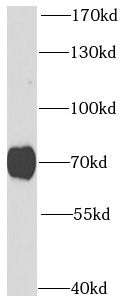Products
PRKG1 antibody
Category:
Research Area:
- SPECIFICATIONS
- Product Name
- PRKG1 antibody
- Catalogue No.
- FNab06786
- Size
- 100μg
- Form
- liquid
- Purification
- Immunogen affinity purified
- Purity
- ≥95% as determined by SDS-PAGE
- Clonality
- polyclonal
- Isotype
- IgG
- Storage
- PBS with 0.02% sodium azide and 50% glycerol pH 7.3, -20℃ for 12 months (Avoid repeated freeze / thaw cycles.)
Immunogen
- Immunogen
- protein kinase, cGMP-dependent, type I
- Alternative Names
- PRKG1B antibody, PRKGR1A antibody, PRKGR1B antibody
- UniProt ID
- Q13976
- Observed MW
- 65 kDa
Application
- Tested Applications
- ELISA, WB, IHC, IF
- Recommended dilution
- WB: 1:500 - 1:2000; IHC: 1:50 - 1:100; IF: 1:50 - 1:200
Validated Images
 HepG2 cells were subjected to SDS PAGE followed by western blot with FNab06786(PRKG1 antibody) at dilution of 1:1000
HepG2 cells were subjected to SDS PAGE followed by western blot with FNab06786(PRKG1 antibody) at dilution of 1:1000
 Immunohistochemistry of paraffin-embedded mouse lung using FNab06786(PRKG1 antibody) at dilution of 1:100
Immunohistochemistry of paraffin-embedded mouse lung using FNab06786(PRKG1 antibody) at dilution of 1:100
- Background
- Mammals have three different isoforms of cyclic GMP-dependent protein kinase (Ialpha, Ibeta, and II). These PRKG isoforms act as key mediators of the nitric oxide/cGMP signaling pathway and are important components of many signal transduction processes in diverse cell types. This PRKG1 gene on human chromosome 10 encodes the soluble Ialpha and Ibeta isoforms of PRKG by alternative transcript splicing. A separate gene on human chromosome 4, PRKG2, encodes the membrane-bound PRKG isoform II. The PRKG1 proteins play a central role in regulating cardiovascular and neuronal functions in addition to relaxing smooth muscle tone, preventing platelet aggregation, and modulating cell growth. This gene is most strongly expressed in all types of smooth muscle, platelets, cerebellar Purkinje cells, hippocampal neurons, and the lateral amygdala. Isoforms Ialpha and Ibeta have identical cGMP-binding and catalytic domains but differ in their leucine/isoleucine zipper and autoinhibitory sequences and therefore differ in their dimerization substrates and kinase enzyme activity.



